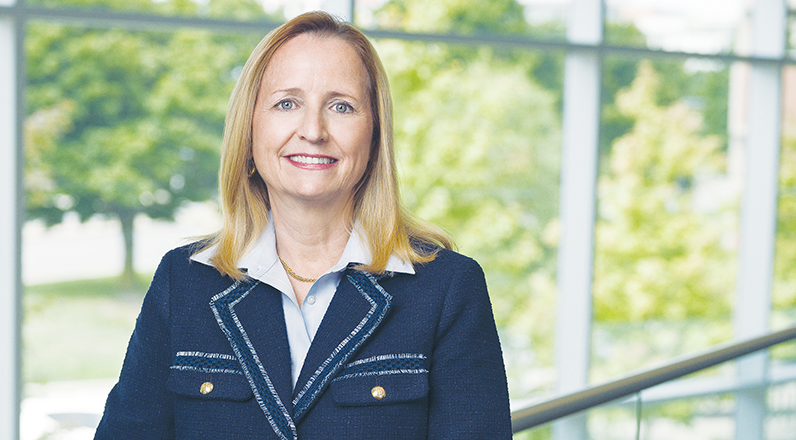
Joyce Markiewicz
When Joyce Markiewicz became president and CEO of Catholic Health in September, she took the helm of a system grappling with formidable challenges: Some communities in its Western New York service area are among the most impoverished and their residents have some of the worst health outcomes in the nation.
But Markiewicz has made a name for herself over her 19-year career at Catholic Health as someone who can get things done, and she's already spearheading some changes to tackle the issues that are vexing communities in the Buffalo, New York-based system's service area.
The four-hospital Catholic Health has six campuses throughout Western New York. Early in her career, Markiewicz helped orchestrate a dramatic turnaround in Catholic Health's home care division. She later assumed leadership of the system's nursing homes, Programs of All-Inclusive Care of the Elderly, and women's, orthopedic, imaging, and laboratory services.
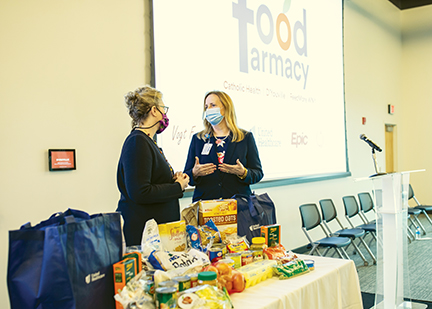
In her most recent role as executive vice president and chief business development officer, she expanded service lines and forged partnerships that led to the construction of a new "neighborhood hospital" in Lockport, New York. That hospital is a campus of the system's Mount St. Mary's Hospital in nearby Lewiston, New York.
Markiewicz spoke to Catholic Health World about how Catholic Health is taking on the challenges before it. Her responses have been edited for length and clarity:
How has your transition to the CEO role been going?
When I was asked to assume this role, there was this calmness for me because this is the culmination of my 19-year career at Catholic Health. I am well prepared to step in. I already
have these strong relationships with the physicians and associates here. And I'm excited to have this new opportunity. Over the years, I've listened to how leadership is making decisions and questioned what we can do better, and now there's an opportunity
to set that direction.
How has the work you've been focused on most recently prepared you for the new challenges you're taking on as CEO?
The role I had immediately prior to becoming CEO was a brand new role at Catholic Health, and right after I started,
the pandemic hit. While everyone else was focused on the day-to-day work of responding to the pandemic, I had to separate myself from that focus and ask, "Where will we be after the pandemic? How do I help ensure we're moving in the right direction
now?" I was having conversations with companies about expanding telemedicine and pharmacy services, for instance.
Then we concentrated our attention on a nearby community in our area whose hospital, Eastern Niagara Hospital, was going bankrupt. We wanted to see what we could do to preserve health care for the community's 80,000 residents. At first, we looked at how we could help the hospital remain open, but soon realized its operations were not sustainable. We needed a new vision. For the past three years, that has been a huge focus for me, and we worked on a wonderful opportunity to build a new micro hospital — Lockport Memorial Hospital.
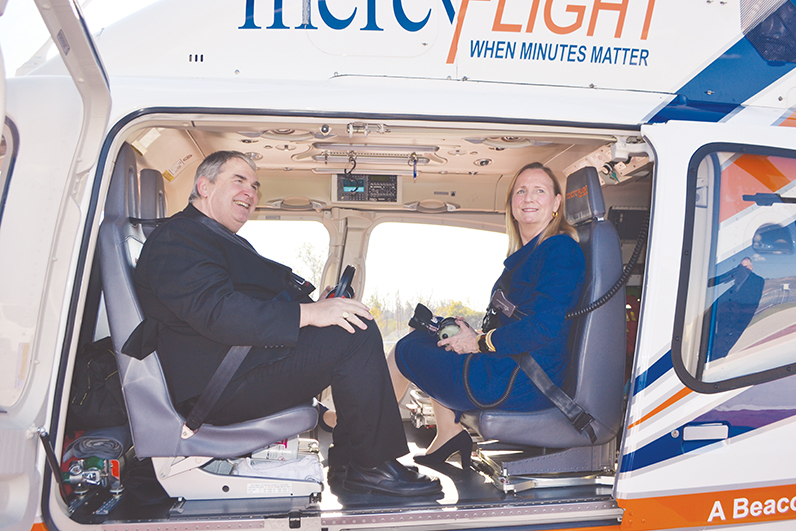
Joyce Markiewicz, Catholic Health president and CEO, and Bishop Michael W. Fisher of Buffalo prepare to take a ride in a Mercy Flight helicopter following the blessing and dedication of Lockport Memorial Hospital in October 2023.
What does the health care provider environment look like in Western New York?
We are the second largest health care employer, and one of two major health systems in the region. There's always been a level of competition between us.
Some people say you don't need two major systems in a community our size. But a lack of competition would breed complacency. In this health care environment, we are always striving to do our best. And we are starting to look at more opportunities
to work together — our two health systems — including when it comes to areas like health equity and community improvement.
What are some of the dynamics of the Western New York communities Catholic Health is serving that are driving decisions your system is making?
We are a very diverse community with a mix of races and nationalities. We have many pockets
of different immigrant groups in our community, and that is a beautiful thing.
But when you look at Erie County, and Buffalo, which is the major metropolitan area we serve, you see that there is much poverty. Buffalo has the seventh highest poverty rate in the U.S. We have pockets where there is high poverty, urban food deserts, and low median incomes. And we see a correlation between the poverty and problems with the education system, where some groups have much less education.
In Niagara County there are some of the worst health outcomes in all of New York state, in terms of mortality, obesity and chronic disease. These are some of the major reasons we were motivated to build our new facility, Lockport Memorial Hospital, after the community's hospital closed.
Something else we looked at was our population declining, with young people leaving the region. But then there was a renaissance happening in Buffalo and there was an uptick in population and things were stabilizing. Something else that's top of mind for us is that we have a very, very large aging population.
What are some of the top challenges your system is facing?
Our challenges are no different than what the majority of health systems are facing now. The pandemic made a huge impact on our finances. And we have a laser focus on how
we get ourselves into the position of having a sufficient number of days' cash on hand. We were in a good position prior to the pandemic and that has eroded.
It's not just because of supply chain costs but also because of workforce issues. We have to solve this issue as a nation — there is a lack of workforce when it comes to nurses and really in all areas of health care.
An area that has grown tremendously across the country is agency staffing. We're paying agencies exorbitant rates and that has a great effect on the bottom line. There's a reimbursement issue here, and we need payers to recognize this.
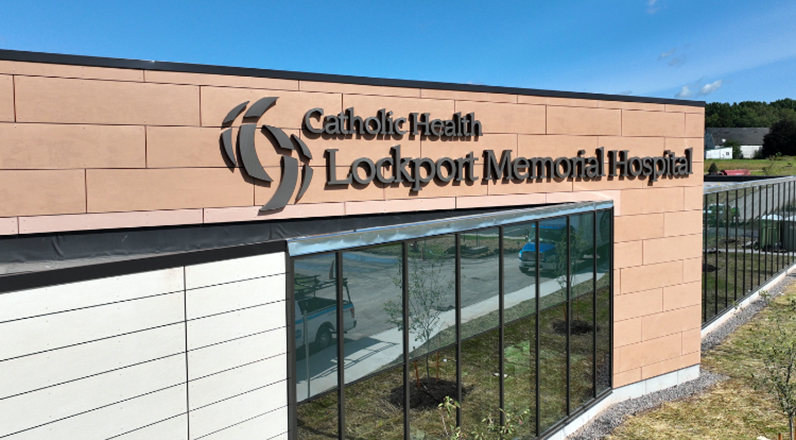
Lockport Memorial Hospital, a campus of Mount St. Mary’s Hospital, opened Oct. 10 in Lockport, New York. Buffalo, New York-based Catholic Health built the hospital after the closure of a nearby community hospital.
What are some of the ways Catholic Health is being innovative in addressing the challenges it is facing?
The Lockport Memorial Hospital we opened recently is a good example.
When we decided to go into that market, people expected that the new hospital would look like the old one, but we found that that wasn't a sustainable model. We are fortunate to be part of a health system where we can change how we think of things and how and where we deliver care, be it in the hospital, or outpatient or home care setting.
We ask, "Where is the best place for the patient to get care?" "Where should the patient be?" It's not in the emergency department.
For the community where the bankrupt hospital was located, we did a deep dive into the demographics, where people access care, and where the gaps were in services. We saw that people had to travel far for high-end care. And we saw that they had maternity services but were delivering less than one baby a day. In that situation, you're not delivering the highest quality care because it's difficult if you don't have the volume. And the same was true for surgery. They had difficulty recruiting surgeons and anesthesiologists.
So we took over operations of an ambulatory surgery center that was part of the shuttered hospital, to better meet the surgical needs of patients throughout Niagara County, where Mount St. Mary's and Lockport Memorial hospitals are located.
We looked at the scope of practice and the low acuity of the patients admitted on campus at Eastern Niagara. We decided that for higher acuity procedures we could stabilize people at Lockport Memorial and then transport them to the right level of care at our other hospitals.
And all this enabled us to look at the workforce differently at the new hospital. We cross-trained our nurses to work in emergency as well as in inpatient settings as well as our radiology techs to be proficient in various imaging modalities. So far it is working beautifully. And as it turns out we only needed to transfer a small number of patients to a higher-acuity settings.
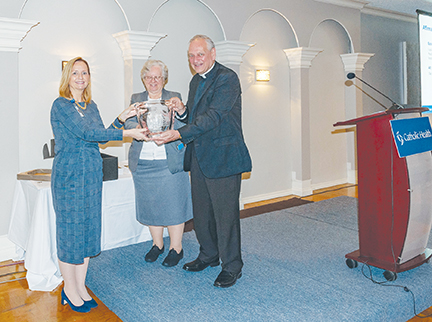
Joyce Markiewicz, left, is commissioned as Catholic Health president and CEO in September. Msgr. Robert E. Zapfel, STD, chair of Catholic Health's corporate members and sponsors council, and Sr. Marcia Ann Fiutko, a member of the council, presented Markiewicz with a crystal bowl etched with a picture of Jesus washing the feet of Peter.
The bottom line is that we're looking at how to get people to the best level of care at the best location. And we're using this as a model to look at concierge care and for using more telemedicine and having it in every room in the new hospital. And we're using Lockport Memorial to test technology and maximize the use of our Epic electronic medical records system.
What are some of the ways Catholic Health is addressing the workforce issue?
We are going upstream, working with colleges and universities in our market. We're supporting schools to provide the workforce of the future. For instance,
we're putting some of our services on their campuses. We're collaborating with one school to fund scholarships for our associates to become nurses and clinical professionals.
Additionally, we've started our own staffing agency where nurses can pick and choose shifts.
We've also started residencies to give new nurses opportunities to get more clinical experience as they join our system.
We've also been looking at benefits, financial compensation and recognition programs.
Most of our campuses have nursing councils and we learn from them. Our associates can share their input about the changes they'd like to see.
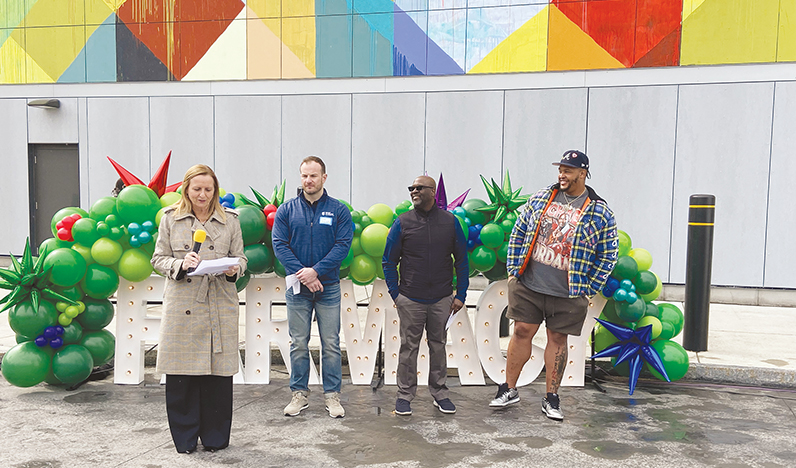
Joyce Markiewicz, then-Catholic Health chief development officer, addresses a gathering at the Westside Food FARMacy Festival at the D'Youville Health Hub in May 2023.
What are ways you're improving how you address diversity, equity and inclusion?
We have a large DE&I committee that sponsors programs and educational activities, and we brought in an outside consultant to expand our efforts.
Most importantly, we now have a full-time director of DE&I, Ida Gibson, to guide this important work. She is coordinating the work of our DE&I committee and outside consultant to have a more focused systemwide effort. We want this to be a
place where people feel welcomed, and we want to focus on inclusion.
What are some of the main messages you're sharing with your own employees about what's ahead?
I attend every orientation session. I speak to new hires about the pressures in society and how it is so important to be kind to each other.
I speak about finding joy in your work. I'm committed to helping them feel joy. I want them to understand the importance of the work they're doing.
And I've been going around and meeting with associate and physician groups around our system. And I'm finding there is a sense of hope. We know it's been a difficult couple of years and we're not out of the woods yet, but we have a sense of hope that if we work together, we can get to the other side and be successful. We still believe in Catholic health care and in the work we do.
